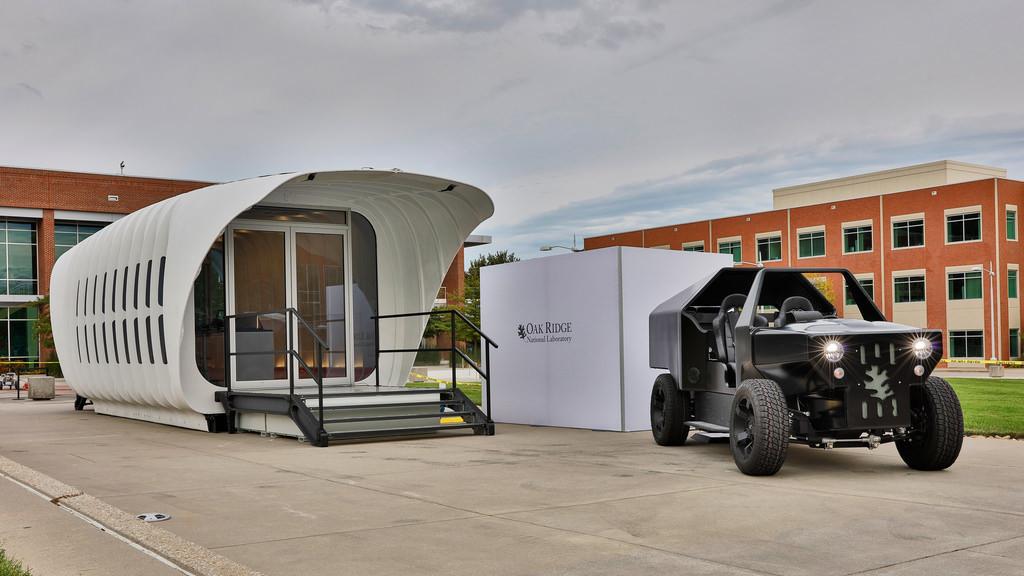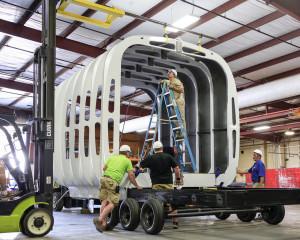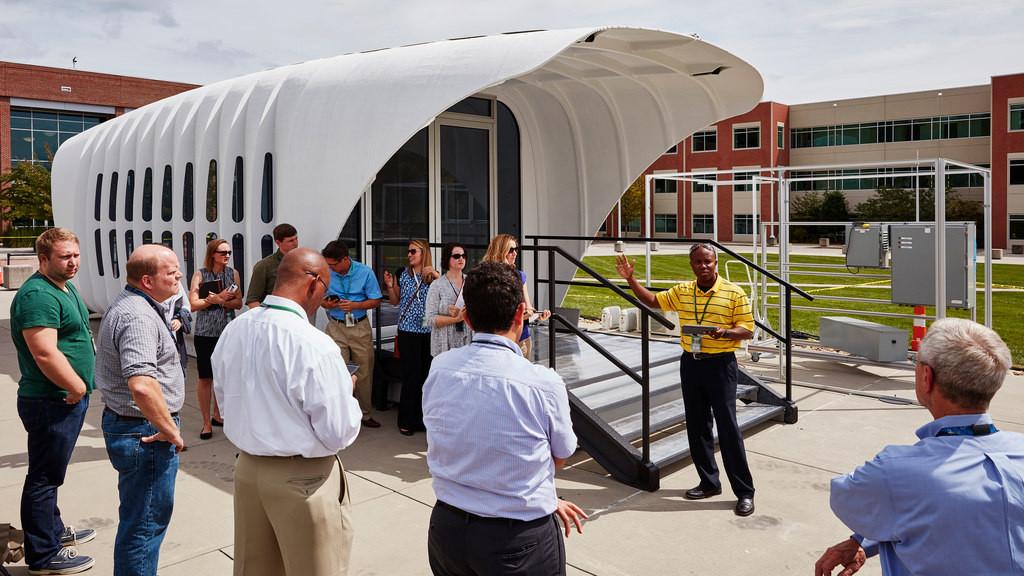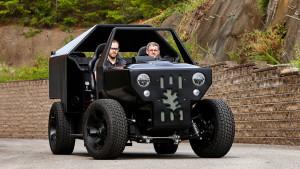 The Department of Energy’s Oak Ridge National Laboratory has unveiled an impressive demonstration of their new integrated 3D printed building and vehicle concept called AMIE, which we first heard about more than a month ago. The Additive Manufacturing Integrated Energy project brings clean energy technologies and large-scale 3D printing together to showcase their novel and revolutionary approach to the use, storage and consumption of energy. At today’s ORNL Energy Efficiency and Renewable Energy (EERE) Industry Day event the advanced research lab showed off their working concept for an energy-efficient system that will link buildings and vehicles together, allowing both to operate off the grid.
The Department of Energy’s Oak Ridge National Laboratory has unveiled an impressive demonstration of their new integrated 3D printed building and vehicle concept called AMIE, which we first heard about more than a month ago. The Additive Manufacturing Integrated Energy project brings clean energy technologies and large-scale 3D printing together to showcase their novel and revolutionary approach to the use, storage and consumption of energy. At today’s ORNL Energy Efficiency and Renewable Energy (EERE) Industry Day event the advanced research lab showed off their working concept for an energy-efficient system that will link buildings and vehicles together, allowing both to operate off the grid.
AMIE was conceived only a year ago, and to already have transitioned from concept to functional prototype is impressive all on its own, but add to that the advanced technology that was developed to make it work and it is nothing short of breath taking. The AMIE project connects a natural gas-powered hybrid electric vehicle to a solar-powered structure and creates a fully integrated energy system shared between both. Power freely flows between the vehicle and the building using new and exciting lab-developed wireless technology.
Essentially, on days when the solar cells on the house are not sufficient to run household operations it can use the natural gas engine in the hybrid vehicle to provide itself with supplemental power. Alternately, the batteries in the hybrid vehicle can be charged using the home’s solar cells. AMIE’s advanced power management and building controls are designed to maximize the efficiency of the energy flow between the house and the vehicle. The electrical demand and usage is perfectly balanced between the building’s 3.2-kilowatt solar array and any power generated from the hybrid vehicle by AMIE’s energy control center. This unique connection allows AMIE to supplement any energy shortages on one side of the system with energy overflow from the other.
Here is a brief demonstration of the energy flow between the house and the vehicle:
In addition to this unique power-share system, AMIE is also a showcase for potential construction and vehicle fabrication applications for additive manufacturing technology. Both the 210-square-foot house and the connected utility vehicle were 3D printed using ORNL’s BAAM large-scale 3D printers. Architecture firm Skidmore, Owings, and Merrill (SOM) worked with the University of Tennessee-ORNL Governor’s Chair for Energy and Urbanism to design the energy and space efficient 38 x 12 x 13 foot building. The actual assembly and fabrication was handled by one of the country’s largest manufactured housing companies, Clayton Homes, as a proof of concept for inexpensive, quick to assemble urban housing.
“Working together, we designed a building that innovates construction and building practices and a vehicle with a long enough range to serve as a primary power source. Our integrated system allows you to get multiple uses out your vehicle,” explained Roderick Jackson, ORNL’s AMIE demonstration project leader.
The connection built between the 3D printed home and 3D printed vehicle demonstrates the viability of integrating and sharing of two energy streams that typically operate independently. ORNL researchers developed their integrated approach to energy generation, storage and consumption to inspire potential improvements to the modern electric grid. The need to integrate renewable energy into the transportation sector is a vital step in transitioning into the eventual elimination of fossil fuel generated energy. And connecting both the home’s electric grid with the power generating capabilities of a hybrid vehicle can create a system capable of dealing with emergencies, disasters and extreme weather events with little to no interruptions to a modern home’s energy needs.
Here is a video showing off the advanced technologies used to bring AMIE to life:
“We’re looking at large community issues from the single-unit level. Our research provides solutions on a small scale, which will translate to a significant reduction in energy use and an increase in cost savings when ramped up to a national, and even global, level,” said ORNL’s associate laboratory director for Energy and Environmental Sciences Martin Keller.
ORNL’s Laboratory Directed Research and Development program worked closely with the Energy Department’s Building Technologies Office, Advanced Manufacturing Office and their Vehicle Technologies Office to support the project. ORNL worked with almost twenty private businesses, organizations and educational facilities to bring AMIE from concept to a functional prototype in just under a year. Some of the national partners included Clayton Homes, GE Appliances, the Institute for Advanced Composite Manufacturing Innovation, Skidmore, Owings & Merrill LLP and University of Tennessee’s College of Architecture and Design. You can see more images of the AMIE concept and fabrication over on ORNL’s Flickr page.
The advances showcased by AMIE, if incorporated into the United States’ modern power grid, could potentially solve the current housing shortage, our over reliance on fossil fuels and the disastrous environmental impact that both problems cause. But the technology developed could also for the first time bring clean, reliable and stable energy production to nations that do not have the same infrastructure as the United States. Realistically, AMIE could transform developing nations into fully developed nations virtually overnight.
Could this be the future of green energy and manufacturing? Discuss in the ORNL Home and Vehicle forum thread on 3DPB.com.
Subscribe to Our Email Newsletter
Stay up-to-date on all the latest news from the 3D printing industry and receive information and offers from third party vendors.
Print Services
Upload your 3D Models and get them printed quickly and efficiently.
You May Also Like
3D Printing News Briefs, July 2, 2025: Copper Alloys, Defense Manufacturing, & More
We’re starting off with metals in today’s 3D Printing News Briefs, as Farsoon has unveiled a large-scale AM solution for copper alloys, and Meltio used its wire-laser metal solution to...
3DPOD 260: John Hart on VulcanForms, MIT, Desktop Metal and More
John Hart is a Professor at MIT; he´s also the director of the Laboratory for Manufacturing and Productivity as well as the director of the Center for Advanced Production Technologies....
3D Printing News Briefs, June 28, 2025: Defense Accelerator, Surgical Models, & More
In this weekend’s 3D Printing News Briefs, 3YOURMIND was selected to join an EU Defense Accelerator, and PTC has announced model-based definition (MBD) capabilities within Onshape. Finally, a study out...
EOS in India: AM’s Rising Star
EOS is doubling down on India. With a growing base of aerospace startups, new government policies, and a massive engineering workforce, India is quickly becoming one of the most important...






































